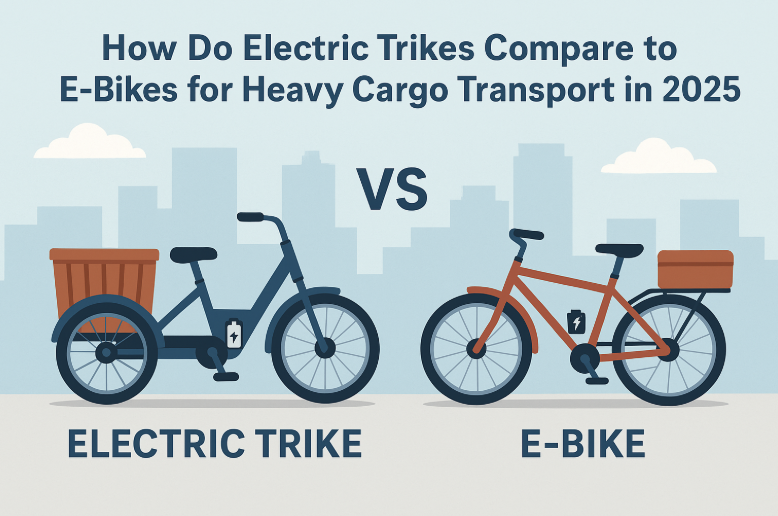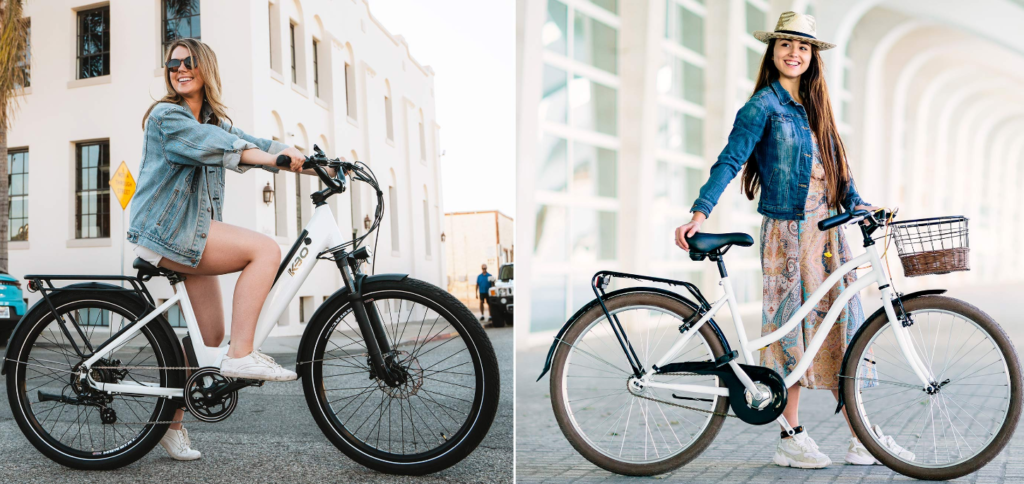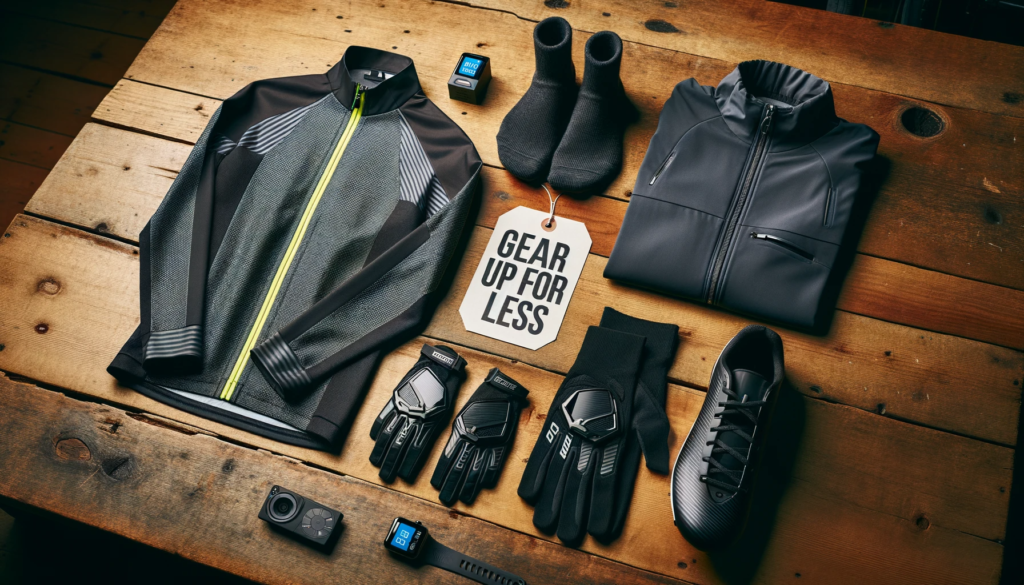Electric bikes and trikes are changing the way we move things, especially in cities. In 2025, more people are turning to these electric rides not just for commuting, but for carrying heavy cargo.
So, if you’re also thinking about moving heavy cargo in 2025, you might be wondering whether an electric trike or an e-bike is the better choice. Both are fantastic for getting around without a car, but they’re built differently and serve unique purposes.
Whether it’s for work deliveries, family groceries, or just hauling gear around town, knowing the right choice matters.
So, how do electric trikes compare to e-bikes for heavy cargo transport?
Let’s break it down in a clear, easy way, so you can decide which one fits your needs.
1. Stability: Which One Keeps Your Cargo Steady?
When you’re carrying heavy stuff, stability is a big deal. You don’t want your cargo wobbling or tipping over. Let’s see how electric trikes and e-bikes stack up.
Electric Trikes: Rock-Solid Balance
Electric trikes have three wheels, usually two at the back and one in the front, which makes them super stable. This is especially true at low speeds or when you’re stopped. The extra wheel gives you a wider base, so even if you’re hauling 300 pounds of groceries or gear, you’re less likely to tip. For example, models like the ADDMOTOR CITYTRI E-310, which you can read about in this in-depth review, can carry up to 380lbs without breaking a sweat. Trikes are perfect for anyone who needs to stay balanced, like seniors or folks carrying bulky loads.
E-Bikes: Great for Speed, Less for Balance
E-bikes, or electric bicycles, are two-wheelers with pedal assist or throttle support. They’re fast, agile, and fun. But they are less stable than trikes, especially when loaded with heavy cargo. At low speeds or when you’re stopped, you have to balance the bike yourself. This can be tricky if you’re carrying a lot of weight.
The Verdict on Stability
If stability is your top priority, trikes win hands down. Their three-wheel design makes them ideal for heavy cargo, especially if you’re riding slowly or stopping often. E-bikes are better for lighter loads or if you’re comfortable balancing.
2. Cargo Capacity: How Much Can You Carry?
When it comes to hauling heavy cargo, capacity is everything. Let’s compare how much each can handle.
Electric Trikes: Built for Big Loads
Electric trikes are often designed specifically for cargo transport. They come with large rear baskets or cargo boxes, and many models can handle up to 450–550 pounds. That’s almost double what a regular e-bike can carry.
Some electric trikes even feature extra-wide platforms, making them perfect for oversized loads. This makes them perfect for grocery runs, deliveries, or even transporting kids and pets.
E-Bikes: Great for Moderate Loads
E-bikes can carry a lot, but they’re not quite on the same level as trikes. Long-tail cargo e-bikes, can handle up to 350–450 pounds, including the rider. They often have rear racks or front baskets, but the total capacity is usually lower than trikes. If you’re carrying lighter cargo, like a couple of grocery bags or one child, an e-bike works well. For heavier or bulkier loads, you might feel the strain.
The Verdict on Cargo Capacity
Trikes take the lead for heavy cargo transport. Their higher payload capacities and spacious cargo areas make them the go-to choice for big hauls. E-bikes are better for smaller, less bulky loads.
3. Maneuverability: Navigating Streets and Tight Spaces
Carrying heavy cargo is one thing, but getting around easily is another. Let’s talk about how these two handle on the road.
Electric Trikes: Steady but Less Agile
Trikes are stable, but that comes at a cost. Their wider frames, larger turning radius, and three-wheel design make them less nimble. Turning corners or weaving through traffic can feel clunky, especially with models that have two front wheels. They are great for straight paths but needs more space to turn. If you’re riding in open areas or on wide bike paths, this isn’t a big issue. In tight urban spaces, though, trikes can be harder to manage.
E-Bikes: Quick and Nimble
E-bikes shine when it comes to maneuverability. Their two-wheel design and slimmer frame lets you make tight turns and dodge obstacles easily. Even when loaded with cargo, e-bikes feel more like regular bikes, giving you better control in traffic. However, you’ll need to be careful with heavy loads to avoid wobbling.
The Verdict on Maneuverability
E-bikes are the winners for maneuverability. If you’re riding in a city with lots of traffic or narrow paths, an e-bike’s agility is a big plus. Trikes are better for open spaces where tight turns aren’t a concern.
4. Battery Life and Range: How Far Can You Go?
When hauling heavy cargo, you need enough battery power to get where you’re going. Let’s see how trikes and e-bikes compare.
Electric Trikes: Long Range for Heavy Loads
Trikes often have powerful batteries to handle their weight and cargo. For instance, the ADDMOTOR CITYTRI E-310 Electric Trike, come with 750W–1000W motors and high-capacity batteries, giving them the strength to haul serious loads without slowing down. These trikes are engineered for cargo transport, with performance that beats many e-bikes in raw power. However, heavy loads can reduce this range by 10–20%. Many trikes offer dual-battery options to extend range even further. This makes them great for long trips or deliveries.
E-Bikes: Decent Range but Less Capacity
E-bikes also have solid battery life, but their range is often shorter than trikes when carrying heavy cargo. A typical cargo e-bike offers a range of 40–60 miles with a 48V 20Ah battery. Heavy loads can cut this down significantly, sometimes to 30 miles or less. Some e-bikes allow for battery upgrades, but they’re generally less equipped for long-distance hauls compared to trikes.
The Verdict on Battery Life
Trikes generally offer better range for heavy cargo due to their larger batteries and dual-battery options. E-bikes are fine for shorter trips or lighter loads but may require more frequent charging for heavy-duty tasks.

5. Cost: Which One Fits Your Budget?
Price is a big factor when choosing between a trike and an e-bike. Let’s break down the costs.
Electric Trikes: Higher Upfront Cost
Electric trikes cost more upfront. Prices typically range between $2,500–$5,500 or more, depending on motor strength, battery size, and cargo design. Maintenance is also a bit higher since trikes have more parts, like extra wheels and brakes. But you’re getting a purpose-built machine with better load handling, safety features, and comfort. If cargo is a daily task, the extra investment in a high-performance trike often pays off.
E-Bikes: More Budget-Friendly
A good-quality cargo-capable e-bike starts around $1,500–$3,000. That makes them accessible to many people. Add-ons like racks or trailers are extra, but they still come in cheaper than most trikes. Maintenance costs are lower too, with fewer parts to worry about. For budget-conscious buyers, e-bikes are a great option.
The Verdict on Cost
E-bikes are more affordable, making them a good choice if you’re watching your wallet. Trikes cost more upfront but may be worth it if you need their extra capacity and stability.
6. Comfort and Ease of Use: Which Feels Better?
Carrying heavy cargo is hard work, so comfort matters. Let’s see which option feels better to ride.
Electric Trikes: Easy to Ride
Trikes offer a low step-through frame, making it easy to get on and off—especially helpful when carrying extra weight. Many also have padded seats with backrests. Plus, since you don’t need to balance at stops, riding a trike feels more secure.
Some models also include fat tires, rear suspension, and parking brakes, which make the ride even smoother and safer.
E-Bikes: Familiar but Demanding
E-bikes feel more like regular bikes, which is great if you’re used to cycling. They’re lightweight and responsive. Most e-bikes offer adjustable pedal assist, good suspension, and comfortable saddles. But riding with a heavy load can still feel wobbly. Stopping at traffic lights or going uphill may take extra effort.
The Verdict on Comfort
Trikes are more comfortable and easier to ride for most people, especially with heavy loads. E-bikes are great if you’re an experienced rider who enjoys a bike-like feel.
7. Practical Use Cases: When to Choose Each
Now that we’ve covered the main differences, let’s talk about when each option shines.
When to Choose an Electric Trike
- Heavy Loads: If you’re hauling over 300 pounds regularly, like for deliveries or big grocery runs, trikes are the way to go.
- Stability Needs: Trikes are perfect for seniors, beginners, or anyone who wants extra balance.
- Long Distances: If you need to travel far with heavy cargo, trikes’ larger batteries make them ideal.
- Open Spaces: Trikes work best on wide paths or open areas where maneuverability isn’t a big issue.
When to Choose an E-Bike
- Urban Environments: If you’re riding in busy cities with tight spaces, e-bikes are easier to handle.
- Lighter Loads: For moderate cargo, like a few bags or one child, e-bikes are more than enough.
- Budget Constraints: If you want a cheaper option, e-bikes are more affordable.
- Active Riders: If you enjoy a bike-like feel and don’t mind balancing, e-bikes are a fun choice.
Final Thoughts: Which Should You Pick?
In 2025, both electric trikes and e-bikes have their place in the world of cargo transport. But if your priority is heavy loads, comfort, and stability, electric trikes come out on top.
However, if you’re navigating city streets, carrying lighter loads, or working with a tighter budget, a cargo e-bike is a great choice.
Think about where you’ll ride, how much you’ll carry, and what feels comfortable for you.




